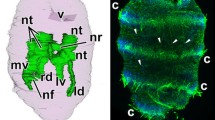Summary
Interstitial cells of hydra are small undifferentiated cells containing an abundance of free ribosomes and few other cytoplasmic organelles. They are capable of differentiating into epitheliomuscular, digestive, glandular, nerve cells, and cnidoblasts. Develo** epitheliomuscular and digestive cells acquire bundles of filaments, 50 Å in diameter, which later are incorporated into the muscular processes. Early gland cells develop an elaborate rough-surfaced endoplasmic reticulum and one or more Golgi apparatus. Secretory granules originate in the Golgi region eventually filling the apex of the cell. Neurons are recognized first by the presence of an elaborate Golgi apparatus, absence of a well-developed endoplasmic reticulum, and later the appearance of cytoplasmic processes. The most striking feature of nematocyst formation by cnidoblasts is the presence of a complex distribution system between protein synthesizing rough-surfaced endoplasmic reticulum and the nematocyst. This system consists of connections between cisternae of the endoplasmic reticulum with smooth Golgi vesicles which in turn are connected to minute tubules, 200 Å in diameter. The tubules extend from the Golgi region around the nematocyst finally entering the limiting membrane of the nematocyst. It is suggested that the interstitial cells of hydra represent a model system for the investigation of many aspects of cell differentiation.
Similar content being viewed by others
References
Brien, P.: La pérennité somatique. Biol. Rev. 28, 308–349 (1953).
Burnett, A.L.: The maintenance of form in hydra. In: D. Rudnick, ed., Regeneration, p. 27–52. New York: Ronald Press 1962.
Chapman, G.B.: The fine structure of the stenoteles of hydra. In: H.M. Lenhoff and W.F. Loomis, eds., The Biology of Hydra and of some other Coelenterates, p. 131–152. Coral Gables, Florida: Univ. of Miami Press 1961.
—, and L.G. Tilney: Cytological studies of the nematocysts of hydra. I. Desmonemes, isorhizas, cnidocils and supporting structures. J. biophys. biochem. Cytol. 5, 69–78 (1959a).
—: II. The stenoteles. J. biophys. biochem. Cytol. 5, 79–84 (1959b).
Farquhar, M.G., and J.F. Rinehart: Electron microscopic studies of the anterior pituitary gland of castrate rats. Endocrinology 54, 516–541 (1954).
Feldman, D.G.: A method of staining thin sections with lead hydroxide for precipitate-free sections. J. Cell Biol. 15, 592–595 (1962).
Freeman, J.A., and B.O. Spurlock: A new epoxy embedment for electron microscopy. J. Cell Biol. 13, 437–443 (1962).
Hess, A.: The fine structure of cells in Hydra. In: H.M. Lenhoff and W.F. Loomis, eds., The Biology of Hydra and of some other Coelenterates, p. 1–50. Coral Gables, Florida: Univ. of Miami Press 1961.
—, A.I. Cohen, and E.A. Robson: Observations on the structure of hydra as seen with the electron and light microscopes. Quart. J. micr. Sci. 98, 315–326 (1957).
Lentz, T.L., and R.J.Barrnett: Fine structure of the nervous system of Hydra. Amer. Zoologist, in press (1965a).
- Surface specializations of hydra cells: The effect of enzyme inhibitors on ferritin uptake. J. Ultrastruct. Res., in press (1965b).
Loomis, W.F., and H.M. Lenhoff: Growth and sexual differentiation of hydra in mass culture. J. exp. Zool. 132, 555–568 (1956).
Palade, G. E., P. Siekevitz, and L.G. Caro: Structure, chemistry, and function of the pancreatic exocrine cell. In: A.V.S. de Reuck and M.P.Cameron, eds., Ciba Foundation Symposium on The Exocrine Pancreas, p. 23–55. Boston: Little, Brown & Co. 1962.
Sabatini, D.D., K. Bensch, and R.J. Barrnett: The preservation of cellular ultrastructure and enzymatic activity by aldehyde fixation. J. Cell Biol. 17, 19–58 (1963).
Slautterback, D.B.: Nematocyst development. In: H.M. Lenhoff and W.F. Loomis, eds., The Biology of Hydra and of some other Coelenterates, p. 77–129. Coral Gables, Florida: Univ. of Miami Press 1961.
—: Cytoplasmic microtubules. I. Hydra. J. Cell Biol. 18, 367–388 (1963).
—, and D.W. Fawcett: The development of the cnidoblasts of hydra. An electron microscope study of cell differentiation. J. biophys. biochem. Cytol. 5, 441–452 (1959).
Tardent, P.: Regeneration in the hydrozoa. Biol. Rev. 38, 293–333 (1963).
Wood, R.L.: Intercellular attachment in the epithelium of Hydra as revealed by electron microscopy. J. biophys. biochem. Cytol. 6, 343–352 (1959).
Author information
Authors and Affiliations
Additional information
This work was supported by grants from the National Cancer Institute (TlCA-5055) and from the National Institute of Arthritis and Metabolic Diseases (AM-03688), National Institutes of Health, Department of Health, Education and Welfare.
The author is indebted to Dr. Russell J. Barrnett for his guidance and interest throughout this investigation.
Rights and permissions
About this article
Cite this article
Lentz, T.L. The fine structure of differentiating interstitial cells in Hydra . Zeitschrift für Zellforschung 67, 547–560 (1965). https://doi.org/10.1007/BF00342586
Received:
Issue Date:
DOI: https://doi.org/10.1007/BF00342586




